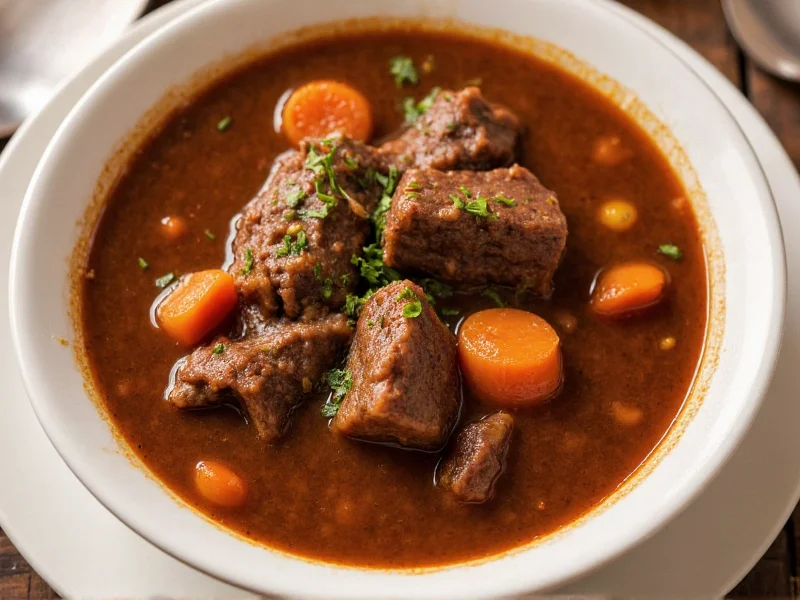Creating exceptional beef ribs soup requires understanding the science behind bone broth development and proper meat preparation. Unlike ordinary soups, the magic happens during the extended simmering process where connective tissues transform into gelatin, enriching both texture and nutritional value. The best results come from using meaty beef short ribs with substantial bone content, typically requiring 3-4 hours of careful simmering to achieve perfect tenderness without disintegrating the meat.
Why Beef Ribs Make Superior Soup
Beef ribs contain abundant collagen-rich connective tissue and marrow that slowly dissolve during cooking, creating a naturally thickened broth with exceptional mouthfeel. The marbling in well-chosen ribs provides flavor complexity that leaner cuts cannot match. When selecting ribs for soup, look for "meaty" cuts with visible bone structure—approximately 60% bone to 40% meat ratio delivers optimal results. This balance ensures sufficient gelatin extraction while providing ample tender meat for serving.
Essential Ingredients Breakdown
The foundation of authentic beef ribs soup rests on quality ingredients working in harmony. Each component serves a specific purpose in developing flavor depth and texture:
| Ingredient | Function | Recommended Quantity |
|---|---|---|
| Meaty beef short ribs | Provides collagen, marrow, and meat | 2-3 lbs per 8 cups broth |
| Yellow onions | Sweetness and aromatic base | 2 large, halved |
| Carrots | Natural sweetness and color | 3 medium, chopped |
| Celery | Earthy depth and complexity | 3 stalks, chopped |
| Garlic | Aromatic foundation | 4 cloves, smashed |
| Apple cider vinegar | Helps extract minerals from bones | 2 tablespoons |
Step-by-Step Preparation Guide
Follow this method for consistently excellent beef ribs soup that showcases the natural flavors of quality ingredients:
- Prepare the ribs: Pat beef ribs dry and season generously with salt and pepper. Sear in a heavy pot over medium-high heat until deeply browned on all sides (about 8-10 minutes total). This Maillard reaction creates complex flavor compounds essential for rich broth.
- Build the aromatic base: Remove ribs and sauté onions, carrots, and celery until softened (about 8 minutes). Add garlic and tomato paste, cooking for 2 more minutes until fragrant.
- Simmer properly: Return ribs to pot, add cold water to cover by 2 inches, 2 tablespoons vinegar, and bay leaves. Bring to gentle simmer (not boil), skimming foam during first 20 minutes. Partially cover and maintain gentle simmer for 3-4 hours.
- Finish with vegetables: During final 45 minutes, add diced potatoes, parsnips, and additional chopped vegetables. Season with salt only at the end to prevent toughening meat.
- Rest and serve: Remove ribs, cool slightly, then separate meat from bones. Return shredded meat to broth. Let soup rest 20 minutes before serving to allow flavors to meld.
Advanced Techniques for Exceptional Results
Professional chefs employ several techniques to elevate basic beef ribs soup to extraordinary levels:
- Dry brine ribs overnight: Salting ribs 12-24 hours before cooking improves moisture retention and flavor penetration
- Roast bones first: For deeper flavor, roast ribs at 400°F for 30 minutes before transferring to pot
- Layered seasoning: Add herbs in stages—hardy herbs like thyme early, delicate herbs like parsley at the end
- Chill and defat: Refrigerate soup overnight; solidified fat layer removes easily for cleaner flavor
- Double reduction: Simmer strained broth further to concentrate flavors without clouding the soup
Regional Variations Worth Trying
Cultures worldwide have developed distinctive beef ribs soup preparations:
Korean Galbi Tang: Features whole beef short ribs simmered with ginger and green onions, served with rice and kimchi. The broth remains clear through careful skimming and gentle simmering.
French Pot-au-Feu: Translates to "pot on the fire," this traditional preparation includes multiple meats and vegetables served in courses, with broth first followed by meats and vegetables.
Mexican Caldo de Costilla: Incorporates cilantro, lime, and sometimes epazote for a bright, herbaceous profile with a touch of heat from jalapeños.
Serving and Storage Recommendations
For optimal enjoyment, serve beef ribs soup hot but not boiling—around 160°F allows flavors to express fully. Garnish with fresh herbs like parsley or cilantro just before serving. The soup improves overnight as flavors continue to meld, making it an excellent make-ahead dish.
Store properly cooled soup in airtight containers for up to 5 days in the refrigerator or freeze for up to 6 months. When reheating, do so gently over medium-low heat to preserve texture—avoid boiling which can make meat tough. The natural gelatin in properly made beef ribs soup will cause it to set when chilled; this is a sign of quality and will liquefy again when reheated.
Troubleshooting Common Issues
Cloudy broth: Caused by boiling too vigorously or not skimming impurities. Solution: Start with cold water, maintain gentle simmer, and skim foam during first 20 minutes.
Bland flavor: Often results from insufficient seasoning or inadequate browning. Solution: Season ribs well before searing and add salt only at the end of cooking.
Tough meat: Typically from insufficient cooking time or starting with water that's too hot. Solution: Simmer gently for full 3-4 hours and always start with cold water.











 浙公网安备
33010002000092号
浙公网安备
33010002000092号 浙B2-20120091-4
浙B2-20120091-4